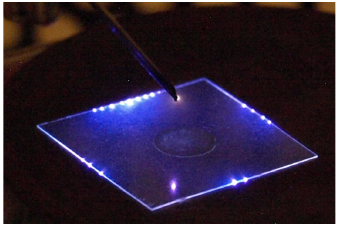
Recovery and resilience plan.


The TS discharge was generated in ambient air at atmospheric pressure in the direct contact with treated water solutions or in the indirect contact where samples were exposed to plasma activated gas flow. In direct plasma treatment the bactericidal effects on bacterial suspensions were accompanied with the decrease of pH, increase of solution conductivity and the chemical changes in water solutions, i.e. formation of various RONS: H2O2, NO2-, NO3-, O3, ONOO- (Machala Z., et al., 2013). Figure 1 shows typical concentration of H2O2, and NO2- and NO3- as determined by ion chromatography during the collaboration with Institute of Plasma Physics in Prague, in water and phosphate buffer (PB) solutions after treatment by the water electrospray system.
The plasma treatment led to the acidification and the production of nitrites, nitrates, peroxides and presumably peroxynitrites in the liquid. At lowered pH, nitrites are quickly oxidized to nitrates and this is associated with the strong bactericidal effect. At neutral pH in buffered solutions, nitrites were less oxidized and the bactericidal effect was weaker. The bactericidal effects seem to correlate with the relative amount of the formed peroxynitrites (Fig. 2, measured by fluorescence of H2DCF-DA probe), as well as with the oxidative stress induced in cell membranes measured by TBARS method (Machala Z., et al., 2013). We are still working on elucidating the potential roles of peroxynitrites, dissolved ozone and nanoparticles from the electrode erosion, and their possible synergies with acidic pH and stable products in water (H2O2, NO2-, and NO3-) in order to get more complex understanding of the plasma induced water chemistry.
Peroxynitrites are postulated to be the key antimicrobial agent in plasma activated water, but their detection is generally difficult because of their high reactivity (very short life-time from milliseconds to seconds) and typically low concentrations (~nM). We investigate the selectivity of the fuorescent dye 2,7-dichlorodihydrofluorescein diacetate (H2DCFDA) with to detect peroxynitrites in plasma activated water (PAW) by air transient spark by using scavengers of reactive oxygen and nitrogen species (RONS) and dyes selective for other RONS. The aim of the study is to distinguish the part of the fluorescence signal that is due to peroxynitrites.